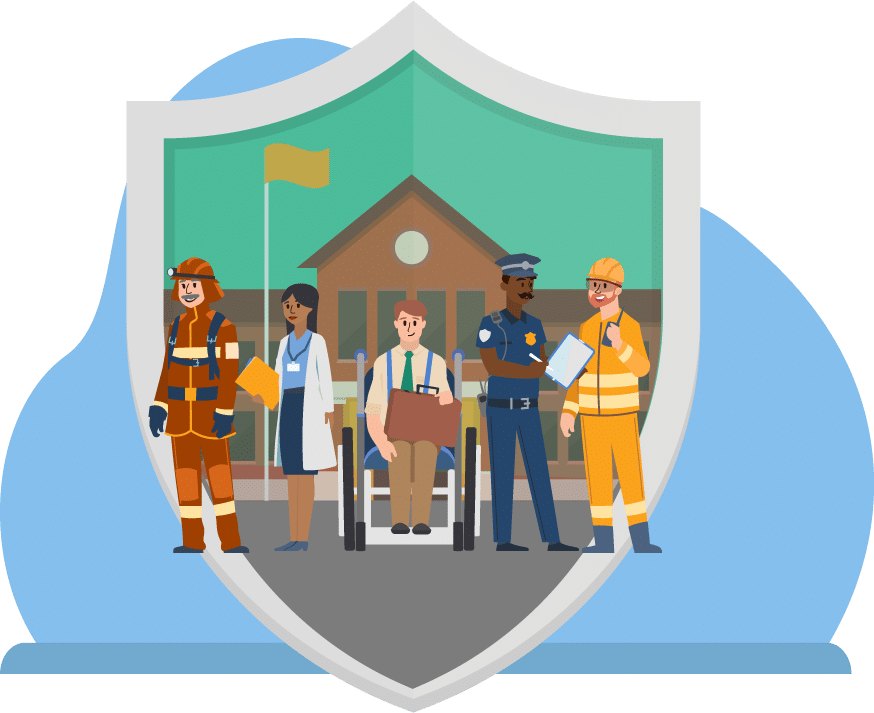Drill Management Best Practices for Schools
Building Confidence, Ensuring Compliance, and Strengthening Preparedness

Table of Contents
- Best Practices for Scheduling & Conducting Safety Drills in Schools
- How to Tailor Safety Drills to Fit Your School’s Unique Requirements
- Ensure Compliance with State and District Requirements for Safety Drills in Schools
- Best Practices for Assessing the Effectiveness of School Safety Drills
- Best Practices for Incorporating an Active Assailant Training Curriculum
Most states require schools to regularly conduct drills, such as:
- Fire evacuation drills
- Lockdown drills
- Severe weather drills
- Shelter-in-place drills
- Earthquake drills (in applicable regions)
- Bus evacuation drills
A drill management solution can help ensure that school safety drills are conducted consistently, effectively, and in compliance with state and district requirements, ultimately strengthening school safety.

1. Best Practices for Scheduling & Conducting Safety Drills in Schools
Drill management software simplifies planning, scheduling, and execution, ensuring consistency across campuses. The most effective solutions also use the same alert mechanisms and response workflows as real emergencies, reinforcing familiarity and confidence for staff.
- Automate Drill Scheduling: Streamline scheduling to ensure schools conduct the required number and types of drills throughout the year, reducing administrative burden and helping districts meet compliance requirements. Ensure drills align with district policies and state mandates without manual tracking.
- Train with Real-World Technology: Use the same emergency alert tools for drills as actual incidents to build muscle memory.
- Coordinate Various Drill Types: Plan fire drills, lockdowns, evacuations, and shelter-in-place exercises to cover different scenarios.
- Notify & Securely Communicate: Keep key personnel, including local fire and law enforcement teams, informed while maintaining drill integrity.
- Ensure Compliance & Accountability: Dashboards provide a clear view of drill completion, helping districts identify schools that may be behind. Comprehensive documentation ensures schools have the necessary records readily available for compliance reporting and analysis.
TIP:
Emergencies can happen at any time, vary drill timing to reflect real-world situations, including during arrival, lunch, or transition periods.
2. How to Tailor Safety Drills to Fit Your School’s Unique Requirements
A well-rounded drill strategy includes various exercises to build confidence, reinforce procedures, and improve emergency response.
- Tabletop Exercises: Small groups discuss scenarios, assign roles, and develop response plans before full-scale drills.
- Walk-Through Drills: Step-by-step practice to familiarize students and staff with emergency procedures in a low-stress setting.
- Preannounced Drills: Scheduled in advance to focus on procedural accuracy and reduce anxiety.
- Unannounced Drills: Not disclosed beforehand but immediately clarified as a drill upon initiation.
FEATURED RESOURCE
School Safety Today Podcast: Understanding the Role of Lockdown Drills
Dr. Jaclyn Schildkraut and Dr. Amanda Nickerson discuss the importance of understanding the role of lockdown drills.
For more immersive emergency training, schools can implement advanced drills that enhance realism and response effectiveness.
- Simulation Drills: Realistic environmental modifications to enhance training for staff and first responders.
- Full-Scale Exercises: Coordinated drills with law enforcement and emergency responders for large-scale scenarios.
School safety drills should be tailored to the developmental level of students to ensure effectiveness without causing unnecessary distress.
- Pre-K – Early Elementary: Young children need clear adult guidance to understand safety concepts.
- Upper Elementary: Can recognize danger but may struggle to differentiate between probable and real threats.
- Middle School: More adept at assessing risk and understanding appropriate responses.
- High School: Typically capable of making informed safety decisions and responding accordingly.
3. Ensure Compliance with State and District Requirements for Safety Drills in Schools
Schools must adhere to state and district mandates regarding the frequency and types of drills conducted. A drill management solution simplifies compliance by:
- Track Completed Drills: Automatically record drill execution, participation, and outcomes.
- Capture Critical Details: Customize drill forms to document key information specific to each drill type.
- Demonstrate Compliance: Provide real-time reporting with audit-ready records to ensure adherence to regulations.
- Ensure Accessible Records: Centralize documentation so administrators and regulatory agencies can run district-wide reports and provide state agencies reports of all drills.
TIP:
Regular compliance checks ensure schools are prepared for audits and regulatory reviews, preventing last-minute documentation issues.
Working alongside local first responders has valuable, far-reaching benefits for schools. It improves coordination and speeds up responses during actual emergencies, and boosts confidence among staff, students, and parents in preparedness efforts. It also strengthens trust and ties between the school and the community.
Here are 4 key ways to develop a strong, collaborative relationship with your school’s first responders:
1. Building Relationships with First Responders
Fostering connections with local emergency agencies lays the foundation for a coordinated response during emergencies.
- Establish regular communication with local emergency officials.
- Arrange onsite visits to familiarize them with the school’s layout and critical areas.
- Define roles and responsibilities to ensure a shared understanding during crises.
2. Involving First Responders in Planning Safety Drills in Schools
Partnering with first responders during drill planning enhances realism and alignment with best practices.
- Consult responders when designing scenarios to reflect real-world protocols.
- Integrate their recommendations to improve drill outcomes.
- Ensure drills meet local safety guidelines and legal requirements.
3. First Responder Participation in School Safety Drills
Having first responders join drills fosters practical engagement and realistic practice.
- Invite responders to take part in key exercises, such as lockdowns or evacuations.
- Simulate response times to test coordination and effectiveness.
- Educate staff and students on what to expect during real emergencies.
4. Post-Drill Debriefing
Reviewing drills with emergency personnel ensures continuous improvement in emergency planning.
- Conduct debriefings to gather feedback on performance and challenges.
- Leverage their expertise to refine procedures and address gaps.
- Use insights to strengthen overall preparedness.
4. Best Practices for Assessing the Effectiveness of School Safety Drills
- Measure Response Times: Identify bottlenecks and areas where staff or students need additional training.
- Analyze Drill Execution Trends: Use reports to assess performance patterns over time.
- Gather Staff & Stakeholder Feedback: Capture real-world insights from teachers, students, and first responders.
- Refine Emergency Protocols: Adjust procedures based on real data rather than assumptions.
TIP:
Post-drill debriefs help identify strengths and areas for improvement, ensuring lessons learned translate into better preparedness.
5. Best Practices for Incorporating an Active Assailant Training Curriculum
- Measure Response Times: Identify bottlenecks and areas where staff or students need additional training.
- Analyze Drill Execution Trends: Use reports to assess performance patterns over time.
- Gather Staff & Stakeholder Feedback: Capture real-world insights from teachers, students, and first responders.
- Refine Emergency Protocols: Adjust procedures based on real data rather than assumptions.
TIP:
Talking about worst-case scenarios, active shooters, and other violent school threats is one of the hardest conversations to have with students, but it’s an important one. Students and staff must know how to keep themselves safe, and in worst-case scenarios, survive and remain calm. How can schools do this without increasing their anxiety or trauma?
The best programs are teacher-led, interactive, adaptable, problem-based, and developed by both school safety and mental health professionals. The curriculum should also be reviewed and updated annually to incorporate the latest best practices and have easy-to-remember strategies.
Programs like Especially Safe from Safe & Sound Schools are designed to help multidisciplinary teams address the safety and security needs of everyone. Another program, Safe Kids Inc.’s H.E.R.O. Program, was designed by experts from law enforcement, education, and school psychology. It emphasizes empowerment based on successful outcomes.
FEATURED RESOURCE
“As much as you try to protect kids from the news, we’re in this over-information age. The news is coming in every direction and the kids are picking up,” Adam Coughran, co-founder of Safe Kids Inc. warns. “We’ve had first and second graders be able to name the Las Vegas shooter by first and last name… Obviously they don’t fully understand [the situation], but they’re piecing together something’s not quite right… We’ve also had high school students tell us [they] are the age or the generation of active shooters.”
Being prepared creates and instills a sense of calm and direction. “Following the empowerment theory essentially means that we can empower kids against [the violence],” Adam continues. When students know how to keep themselves safe, it helps build their confidence and reduce their worry and anxiety around attending school.
School Safety Drills: Practice and More Practice
Get started with the leading supplier of school safety software. Fill out the brief form and someone from our Raptor pack will be in touch.
